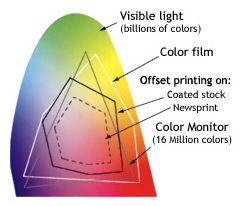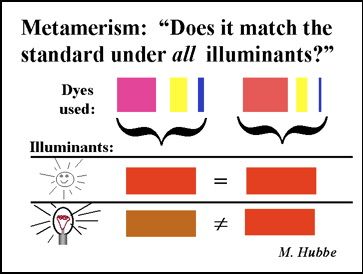A page from the "Causes of Color" exhibit...
How do colors change on the screen compared to when printed?


Computer "spectrum". Mixing the primary colors, as shown in the narrow bands above, creates the colors of the broad upper band.
TV and computer screens
The images displayed on television and computer screens are made up of pixels, each produced by mixing red, green, and blue dots in varying proportions. A combination of all three at maximum brightness will appear white from a distance. A mix of red and green produces yellow; red with blue creates magenta; and green with blue produces cyan. On a screen, varying the proportions of the primary colors creates the whole range of color.
Reproducing color

The range of colors varies enormously across different media. Of the billions of colors in the visible spectrum, a computer screen can display millions, a high-quality printer in the order of thousands, and older computer systems may support only 216 colors across different platforms. There are great difficulties involved in reproducing color in an accurate, repeatable way within the limitations of printing what we see on a screen. Colors must be chosen from the RGB color system to be rendered in the exact colors intended; designs incorporating colors outside the CMYK spectrum may not be properly reproduced in print.


Examples of metamerism
Metamerism and illuminants
Visible light is electromagnetic radiation with a wavelength between about 400 and 700 nanometers. Every color of light has a characteristic spectral distribution, its pattern of light intensity with increasing wavelength. Describing the color of light in this way is much more complex than using the three attributes of hue, saturation, and brightness.
Dividing the whole interval of visible wavelengths into slices 10 nanometers wide, we would still need about 30 attributes to identify each one distinctly. It follows that for each color we perceive, many different spectra will create the same color impression. Spectra we perceive as being the same color are called metamers. Our brain doesn’t distinguish color by the wavelengths we are seeing, only by their combined effect. For example, an object emitting yellow light will look the same color as an object emitting only green and red light (as the green and red combine to appear yellow).
The quality of illumination also affects the color we see when looking at colored surfaces. Light is reflected from these surfaces, which have different spectral reflectance curves. We perceive color based on the combination of the spectral reflectance of the surface, and the quality of its illumination.
Two surfaces (or pigments) may reflect metamer light when illuminated by one light source, but reflect different spectra when illuminated by a different light source. Two colored textiles may look the same color when illuminated by incandescent bulb, but look different under a fluorescent tube.



